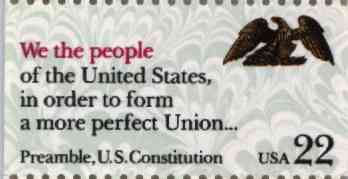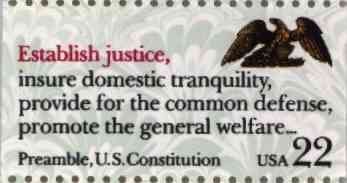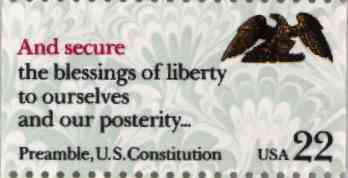FRtR > Outlines > The American Government > The Constitution: An Enduring Document > Drafting the Constitution
An Outline of American Government
The Constitution: An Enduring Document
2/10 Drafting the Constitution
*** Index * < Previous Chapter * Next Chapter > ***
The period between the adoption of the Articles of Confederation in
1781 and the drafting of the new Constitution in 1787 was one of
weakness, dissension and turmoil. Under the Articles of
Confederation, no provisions were made for an executive branch to
enforce the laws nor for a national court system to interpret
them.
 A legislative Congress was the sole organ of the national
government, but it had no power to force the states to do
anything against their will. It could -- theoretically -- declare war and raise an army, but it could not force any state to meet its
assigned quota for troops or for the arms and equipment needed to
support them. It looked to the states for the income needed to
finance its activities, but it could not punish a state for not
contributing its share of the federal budget. Control of
taxation and tariffs was left to the states, and each state could issue
its own currency. In disputes between states -- and there were many
unsettled quarrels over state boundaries -- Congress played the
role of mediator and judge, but could not require the state to
accept its decisions.
A legislative Congress was the sole organ of the national
government, but it had no power to force the states to do
anything against their will. It could -- theoretically -- declare war and raise an army, but it could not force any state to meet its
assigned quota for troops or for the arms and equipment needed to
support them. It looked to the states for the income needed to
finance its activities, but it could not punish a state for not
contributing its share of the federal budget. Control of
taxation and tariffs was left to the states, and each state could issue
its own currency. In disputes between states -- and there were many
unsettled quarrels over state boundaries -- Congress played the
role of mediator and judge, but could not require the state to
accept its decisions.
The result was virtual chaos. Without the power to collect
taxes, the federal government plunged into debt. Seven of the 13 states
printed large quantities of paper money -- high in face value but
low in real purchasing power -- in order to pay veteran soldiers
and a variety of creditors, and to settle debts between small
farmers and large plantation owners.
By contrast, the Massachusetts legislature imposed a tightly
limited currency and high taxes, triggering formation of a small
army of farmers led by Daniel Shays, a former Revolutionary War
army captain. In a bid to take over the Massachusetts
statehouse, Shays and others demanded that foreclosures and unfair mortgages be dropped. Troops were called out to suppress the rebellion, but the federal government took notice.
Absence of a uniform, stable currency also disrupted trade among
the states and with other countries.  Not only did the value of
paper currency vary from state to state, but some states (like
New York and Virginia) levied duties on products entering their ports
from other states, thereby provoking retaliatory actions. The
states could say, as had the federal superintendent of finance,
that "our public credit is gone." To compound their problems,
the newly independent states, having separated violently from
England, no longer received favored treatment at British ports. When
Ambassador John Adams tried to negotiate a commercial treaty in
1785, the British refused on the grounds that the individual
states would not be bound by it. The British were also angered by the
failure of Americans to pay for property confiscated during the
Revolution.
Not only did the value of
paper currency vary from state to state, but some states (like
New York and Virginia) levied duties on products entering their ports
from other states, thereby provoking retaliatory actions. The
states could say, as had the federal superintendent of finance,
that "our public credit is gone." To compound their problems,
the newly independent states, having separated violently from
England, no longer received favored treatment at British ports. When
Ambassador John Adams tried to negotiate a commercial treaty in
1785, the British refused on the grounds that the individual
states would not be bound by it. The British were also angered by the
failure of Americans to pay for property confiscated during the
Revolution.
A weak central government, without the power to back its policies
with military strength, was inevitably handicapped in foreign
affairs as well. The British refused to withdraw their troops
from the forts and trading posts in the new nation's Northwest
Territory, as they had agreed to do in the peace treaty of 1783.
 To make matters worse, British officers on the northern
boundaries and Spanish officers to the south supplied arms to various Indian
tribes and encouraged them to attack American settlers. The
Spanish, who controlled Florida and Louisiana, as well as all
territory west of the Mississippi River, also refused to allow
Western farmers to use the port of New Orleans to ship their
produce.
To make matters worse, British officers on the northern
boundaries and Spanish officers to the south supplied arms to various Indian
tribes and encouraged them to attack American settlers. The
Spanish, who controlled Florida and Louisiana, as well as all
territory west of the Mississippi River, also refused to allow
Western farmers to use the port of New Orleans to ship their
produce.
Although there were signs of returning prosperity in some areas of
the fledgling nation, domestic and foreign problems continued to
grow. It became increasingly clear that the Confederation's
central government was not strong enough to establish a sound
financial system, to regulate trade, to enforce treaties or to
exert military force against foreign antagonists when needed.
Internal divisions between farmers and merchants, debtors and
creditors, and among the states themselves were growing more
severe. With Shay's Rebellion of desperate farmers in 1786 vividly
in mind and only recently crushed, George
Washington warned: "There
are combustibles in every state which a spark might set fire to."
This sense of potential disaster and the need for drastic change
pervaded the Constitutional Convention that began its deliberations
on May 25, 1787. All of the delegates were convinced that an
effective central government with a wide range of enforceable
powers must replace the impotent Congress established by the
Articles of Confederation.  Early in the proceedings the delegates
agreed that the new government would be composed of three separate
branches -- legislative, judicial and executive -- each with
distinct powers to balance those of the other two branches. It was
also agreed that the legislative branch -- like the British
Parliament -- should consist of two houses.
Early in the proceedings the delegates
agreed that the new government would be composed of three separate
branches -- legislative, judicial and executive -- each with
distinct powers to balance those of the other two branches. It was
also agreed that the legislative branch -- like the British
Parliament -- should consist of two houses.
Beyond this point, however, there were sharp differences of opinion
that threatened at times to disrupt the Convention and cut short
its proceedings before a constitution was drafted. The larger
states argued in favor of proportional representation in the
legislature -- each state should have voting power according to its
population. The smaller states, fearing domination by the larger
ones, insisted on equal representation for all states. The issue
was settled by the "Great Compromise," giving every state equal
representation in one house of Congress, and proportional
representation in the other. In the Senate, every state would have
two seats. In the House of Representatives, the number of seats
would depend on population. Because it was considered more
responsive to majority sentiment, the House of Representatives was
given the power to originate all legislation dealing with the
federal budget and revenues.
The Great Compromise ended the rift between the large and small
states, but throughout the long summer numerous other compromises
were made.  Some delegates, fearful of giving too much power to the
people, argued for indirect election of all federal officials;
others wanted as broad an electoral base as possible. Some wanted
to exclude the western territories from eventual statehood; others
saw the future strength of the nation in the virgin lands beyond
the Appalachians. There were sectional interests to be balanced;
differing views to be reconciled on the term, powers and method of
selection of the president; and conflicting ideas on the role of
the federal judiciary.
Some delegates, fearful of giving too much power to the
people, argued for indirect election of all federal officials;
others wanted as broad an electoral base as possible. Some wanted
to exclude the western territories from eventual statehood; others
saw the future strength of the nation in the virgin lands beyond
the Appalachians. There were sectional interests to be balanced;
differing views to be reconciled on the term, powers and method of
selection of the president; and conflicting ideas on the role of
the federal judiciary.
The way to compromise was eased by the high quality of the
delegates to the Convention. Only a few of the great leaders of
the American Revolution were absent: Thomas
Jefferson and John
Adams -- both future presidents -- were serving as America's envoys
to France and England; John
Jay was busy as secretary of foreign
affairs of the Confederation. A handful of others, including
Samuel Adams and Patrick Henry, chose not to participate, believing
that the existing governmental structure was sound. Of those in
attendance, the best known by far was George Washington, hero of
the Revolution, who presided over the Convention.
Benjamin Franklin, the wise old scientist, scholar and diplomat, was
also there. So, too, were such outstanding men as James Madison of
Virginia, Gouverneur Morris of Pennsylvania and
Alexander Hamilton,
the brilliant young lawyer from New York.
Even the youngest delegates, still in their 20s and 30s, had
already displayed political and intellectual gifts. Thomas
Jefferson in Paris wrote to John Adams in London: "It really is
an assembly of demi-gods."
Some of the ideas embodied in the Constitution were new, but many
were drawn from British governmental tradition and from the
practical experience in self-government of the 13 states. The
Declaration of Independence was an important guide, keeping the
minds of the delegates fixed on the ideas of self-government and
preservation of fundamental human rights. The writings of such
European political philosophers as Montesquieu and Locke were also influential.
In late July, a committee was appointed to draft a document based
on the agreements that had been reached. After another month of
discussion and refinement, a second committee, headed by Gouverneur
Morris, produced the final version which was submitted for signing
on September 17. Not all the delegates were pleased with the
results; some left before the ceremony, and three of those
remaining refused to sign: Edmund Randolph and George Mason of
Virginia, and Elbridge Gerry of Massachusetts. Of the 39 who did
sign, probably no one was completely satisfied, and their views
were ably summed up by Benjamin Franklin, who said, "There are
several parts of this Constitution which I do not at present
approve, but I am not sure I shall never approve them." He would
accept the Constitution, however, "because I expect no better and
because I am not sure that it is not the best."
*** Index * Next Chapter > ***
 A legislative Congress was the sole organ of the national
government, but it had no power to force the states to do
anything against their will. It could -- theoretically -- declare war and raise an army, but it could not force any state to meet its
assigned quota for troops or for the arms and equipment needed to
support them. It looked to the states for the income needed to
finance its activities, but it could not punish a state for not
contributing its share of the federal budget. Control of
taxation and tariffs was left to the states, and each state could issue
its own currency. In disputes between states -- and there were many
unsettled quarrels over state boundaries -- Congress played the
role of mediator and judge, but could not require the state to
accept its decisions.
A legislative Congress was the sole organ of the national
government, but it had no power to force the states to do
anything against their will. It could -- theoretically -- declare war and raise an army, but it could not force any state to meet its
assigned quota for troops or for the arms and equipment needed to
support them. It looked to the states for the income needed to
finance its activities, but it could not punish a state for not
contributing its share of the federal budget. Control of
taxation and tariffs was left to the states, and each state could issue
its own currency. In disputes between states -- and there were many
unsettled quarrels over state boundaries -- Congress played the
role of mediator and judge, but could not require the state to
accept its decisions.
 Not only did the value of
paper currency vary from state to state, but some states (like
New York and Virginia) levied duties on products entering their ports
from other states, thereby provoking retaliatory actions. The
states could say, as had the federal superintendent of finance,
that "our public credit is gone." To compound their problems,
the newly independent states, having separated violently from
England, no longer received favored treatment at British ports. When
Ambassador
Not only did the value of
paper currency vary from state to state, but some states (like
New York and Virginia) levied duties on products entering their ports
from other states, thereby provoking retaliatory actions. The
states could say, as had the federal superintendent of finance,
that "our public credit is gone." To compound their problems,
the newly independent states, having separated violently from
England, no longer received favored treatment at British ports. When
Ambassador  To make matters worse, British officers on the northern
boundaries and Spanish officers to the south supplied arms to various Indian
tribes and encouraged them to attack American settlers. The
Spanish, who controlled Florida and Louisiana, as well as all
territory west of the Mississippi River, also refused to allow
Western farmers to use the port of New Orleans to ship their
produce.
To make matters worse, British officers on the northern
boundaries and Spanish officers to the south supplied arms to various Indian
tribes and encouraged them to attack American settlers. The
Spanish, who controlled Florida and Louisiana, as well as all
territory west of the Mississippi River, also refused to allow
Western farmers to use the port of New Orleans to ship their
produce.
 Early in the proceedings the delegates
agreed that the new government would be composed of three separate
branches -- legislative, judicial and executive -- each with
distinct powers to balance those of the other two branches. It was
also agreed that the legislative branch -- like the British
Parliament -- should consist of two houses.
Early in the proceedings the delegates
agreed that the new government would be composed of three separate
branches -- legislative, judicial and executive -- each with
distinct powers to balance those of the other two branches. It was
also agreed that the legislative branch -- like the British
Parliament -- should consist of two houses.
 Some delegates, fearful of giving too much power to the
people, argued for indirect election of all federal officials;
others wanted as broad an electoral base as possible. Some wanted
to exclude the western territories from eventual statehood; others
saw the future strength of the nation in the virgin lands beyond
the Appalachians. There were sectional interests to be balanced;
differing views to be reconciled on the term, powers and method of
selection of the president; and conflicting ideas on the role of
the federal judiciary.
Some delegates, fearful of giving too much power to the
people, argued for indirect election of all federal officials;
others wanted as broad an electoral base as possible. Some wanted
to exclude the western territories from eventual statehood; others
saw the future strength of the nation in the virgin lands beyond
the Appalachians. There were sectional interests to be balanced;
differing views to be reconciled on the term, powers and method of
selection of the president; and conflicting ideas on the role of
the federal judiciary.